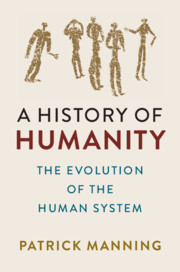Book contents
- A History of Humanity
- A History of Humanity
- Copyright page
- Contents
- Maps, Figures, and Tables
- Preface
- Acknowledgments
- Introduction
- Pleistocene Evolution
- Holocene Evolution
- 6 Society: Network versus Hierarchy
- 7 Collisions and Contraction
- 8 From Global Networks to Capitalism
- Anthropocene Evolution
- Appendix: Frameworks for Analysis
- Notes
- Glossary
- References
- Index
8 - From Global Networks to Capitalism
from Holocene Evolution
Published online by Cambridge University Press: 14 February 2020
- A History of Humanity
- A History of Humanity
- Copyright page
- Contents
- Maps, Figures, and Tables
- Preface
- Acknowledgments
- Introduction
- Pleistocene Evolution
- Holocene Evolution
- 6 Society: Network versus Hierarchy
- 7 Collisions and Contraction
- 8 From Global Networks to Capitalism
- Anthropocene Evolution
- Appendix: Frameworks for Analysis
- Notes
- Glossary
- References
- Index
Summary
Seventeenth-century empires of east and west built four types of profitable colonies. They maintained port cities, labor systems, and trade in precious metals. A comparison of oceanic shipping shows that, while Europeans dominated long-haul routes, Asian shipping dominated the dense Indian Ocean trade. Capitalism entered this scene, gradually gaining global leadership. Its most basic institution was the profit-making enterprise, combining local and international trade. A second institution, the proprietors’ association, linked entrepreneurs to pressure states at home and abroad for pro-enterprise policy in commerce, taxation, diplomacy, and war. Such associations gained an early start in the Netherlands and thereafter in England. A Dutch–English alliance then created a third capitalistic institution, a network of national proprietors’ associations able to sustain pro-capitalist policy among states even as they warred. The chapter concludes with exploration of global cultural exchange and early signals of nationalism and democracy. The changes in economy, culture, and politics relied both on current agency and deep antecedents worldwide.
- Type
- Chapter
- Information
- A History of HumanityThe Evolution of the Human System, pp. 171 - 200Publisher: Cambridge University PressPrint publication year: 2020

